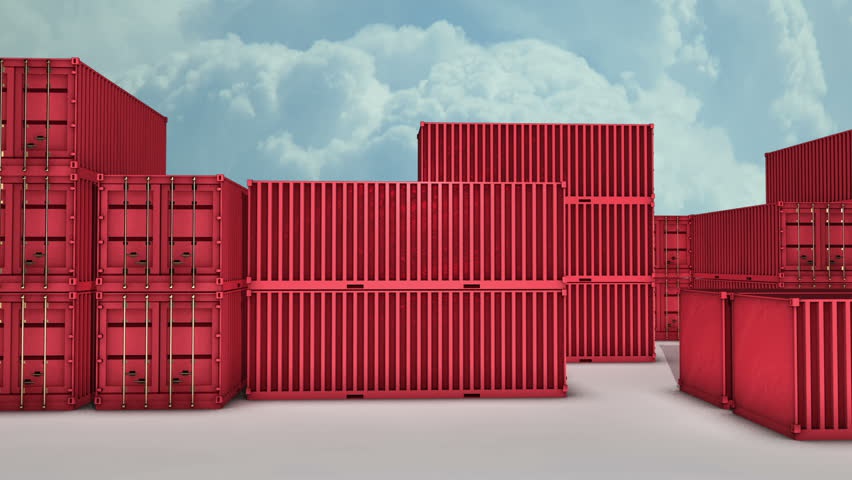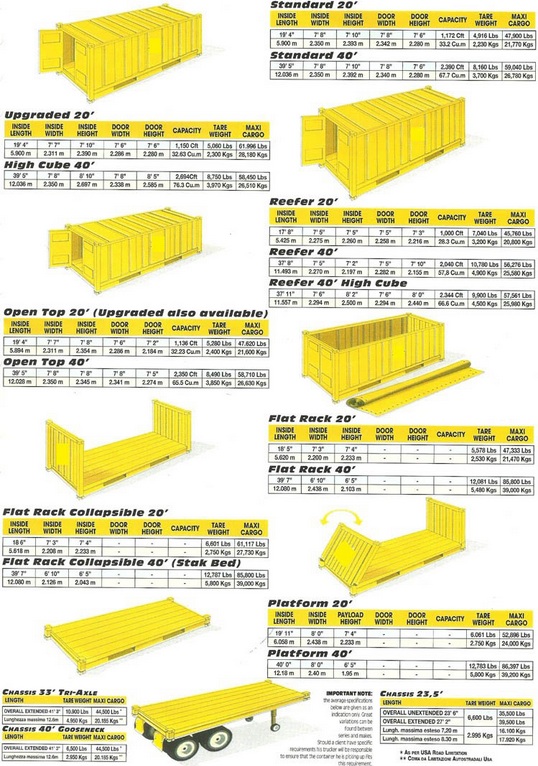Container Sizes And Types
Container sizes of 20 and Container sizes of 40 (20´ DC / 40´ DC)
There are many answers to the question of what are containers. We can define one of them as containers that are used in export, import and long-distance transportation, protected, with certain dimensions, that is, with certain standards.

Although in some commercial correspondence this type of container is called “dry van” or “standard”, the term “general purpose” is often more appropriate. In accordance with international use, their external dimensions can be fixed in terms of length and width, and their heights can be different. It has two doors and only one of them can be opened outwards.

When the door of the container is closed, it has water and airtight feature. The material used in the manufacture of containers is selected considering both the carrying capacity and the volume. Usually steel and aluminum are used. Steel containers have less loading capacity because steel is heavier.

|
20′ Container |
40′ Container |
40′ high volume Container |
||||
|
inner length |
19’4″ |
5.89 m |
39’5″ |
12.01 m |
39’5″ |
12.01 m |
|
Inner Width |
7’8″ |
2.33 m |
7’8″ |
2.33 m |
7’8″ |
2.33 m |
|
interior height |
7’10” |
2.38 m |
7’10” |
2.38 m |
8’10’ |
2.69 m |
|
Door Width |
7’8″ |
2.33 m |
7’8 “ |
2.33m |
7’8″ |
2.33 m |
|
Door height |
7’6″ |
2.28 m |
7’6″ |
2.28 m |
8’5″ |
2.56 m |
|
Capacity |
1,172 ft³ |
33.18 m³ |
2,390 ft³ |
67.67 m³ |
2,694 ft³ |
76.28 m³ |
|
Tare weight |
4,916 lb |
2,229 kg |
8,160 lb |
3,701 kg |
8,750 lb |
3,968 kg |
|
Net load |
47,999 lb |
21,727 kg |
59,040 lb |
26,780 kg |
58,450 lb |
26,512 kg |
20´ Open Top Container Dimensions / 40´ Open Top Container Dimensions (20´ DC / 40´ DC)
It carries the length and width dimensions of a typical general purpose container, with the only difference that it does not have a “fixed top”. It is used in cases where loads that are too long/wide to fit into the container through the door can only be placed from above by cranes or similar vehicles. Mostly machinery, marble plates, aluminum profiles etc. are transported. Open top containers are often used for overflowing loads. It is tightly covered with a tarpaulin after loading. Its base is slightly thicker because it carries heavy loads, and because it falls under the special equipment class, a surcharge is usually added to the freight.
20′ Open Top Container
40′ Open Top Container
inner length
19’4″
5.89 m
39’5″
12.01 m
Inner Width
7’7″
2.31 m
7’8″
2.33m
interior height
7’8″
2.33m
7’8″
2.33m
Door Width
7’6″
2.28m
7’8”
2.33m
door height
7’2″
2.18m
7’5″
2.26m
Capacity / Stamina
1,136 ft³
32.16 m³
2,350 ft³
6.54 m³
tare weight
5,280 lb
2,394 kg
8,490 lb
3,850 kg
net load
47,620 lb
21,600 kg
58,710 lb
26,630 kg
Containers can be loaded in bulk or with pallets. Pallet loading can be done with 80×120 Euro pallets and 100×120 ISO standard pallets. In the chemical industry, palletized shipments, containers are loaded into products using Cp1, Cp2, Cp3, Cp4, Cp5, Cp6, Cp7, Cp8, Cp9. The preference for second (2nd hand) pallets and container loadings has increased considerably due to the reasonable prices of secondhand pallets. There are many articles on our site about how many pallets will fit in the containers, in other words, on the issues of placing pallets in the containers. When making these calculations, the optimum number of pallets that can be placed, that is, the fit, is calculated by taking into account the Euro, ISO pallet sizes and container sizes you use.
20´ Open Top / 40´ Open Top
It carries the length and width dimensions of a typical general purpose container, with the only difference that it does not have a “fixed top”. It is used in cases where loads that are too long/wide to fit into the container through the door can only be placed from above by cranes or similar vehicles. Mostly machinery, marble plates, aluminum profiles etc. are transported. Open top containers are often used for overflowing loads. It is tightly covered with a tarpaulin after loading. Its base is slightly thicker because it carries heavy loads, and because it falls under the special equipment class, a surcharge is usually added to the freight.
20′ Open Top Container
40′ Open Top Container
inner length
19’4″
5.89 m
39’5″
12.01 m
Inner Width
7’7″
2.31 m
7’8″
2.33m
interior height
7’8″
2.33m
7’8″
2.33m
Door Width
7’6″
2.28m
7’8”
2.33m
door height
7’2″
2.18m
7’5″
2.26m
Capacity / Stamina
1,136 ft³
32.16 m³
2,350 ft³
66.54 m³
tare weight
5,280 lb
2,394 kg
8,490 lb
3,850 kg
Net load / Maximum cargo
47,620 lb
21,600 kg
58,710 lb
26,630 kg
20′ Flat Rack Container / 40′ Flat Rack Container
It is also sometimes referred to as “flat” for short. This type of container does not have two sides and a top. Sometimes both heads can be dislodged. A lot of surcharge may be added to the freight because the flat container is suitable for loading goods from both sides and from the top. The bottom of the container is very thick.
20′ Flat Rack Container
40′ Flat Rack Container
inner length
18’5″
5.61 m
39’7″
12.06 m
Inner Width
7’3″
2.20m
6’10”
2.08 m
interior height
7’4″
2.23m
6’5″
1.95m
tare weight
5,578 lb
2,530 kg
12,081 lb
5,479 kg
Net load / Maximum cargo
47,333 lb
21,469 kg
85,800 lb
38,918 kg







